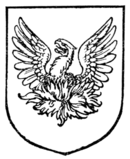no more than a representation of a crest between two wings turned to be represented upon a profile helmet, is one of the painful results of our absurd position rules for the helmet.
A pair of wings conjoined is sometimes termed a vol, and one wing a demi-vol. Though doubtless it is desirable to know these terms, they are but seldom found in use, and are really entirely French.
Eagles' legs are by no means an infrequent charge. They will usually be found erased at the thigh, for which there is a recognised term "erased à la quise" (Fig. 459), which, however, is by no means a compulsory one. An eagle's leg so erased was a badge of the house of Stanley. The eagle's leg will sometimes be met with couped below the feathers, but would then be more properly described as a claw.
A curious form of the eagle is found in the alerion, which is represented without beak or legs. It is difficult to conjecture what may have been the origin of the bird in this debased form, unless its first beginnings may be taken as a result of the unthinking perpetuation of some crudely drawn example. Its best-known appearance is, of course, in the arms of Loraine; and as Planché has pointed out, this is as perfect an example of a canting anagram as can be met with in armory.
The Phœnix (Fig. 460), one of the few mythical birds which heraldry has familiarised us with, is another, and perhaps the most patent example of all, of the appropriation by heraldic art of an ancient symbol, with its symbolism ready made. It belongs to the period of Grecian mythology. As a charge upon a shield it is comparatively rare, though it so occurs in the arms of Samuelson. On the other hand, it is frequently to be found as a crest. It is always represented as a demi-eagle issuing from flames of fire, and though the flames of fire will generally be found mentioned in the verbal blazon, this is not essential. Without its fiery surroundings it would cease to be a phœnix. On the other hand, though it is always depicted as a demi-bird (no instance to the contrary exists), it is never considered necessary to so specify it. It occurs as the crest of the Seymour family ["Out of a ducal coronet a phœnix issuant from flames of fire"].
The Osprey may perhaps be here mentioned, because its heraldic


